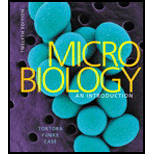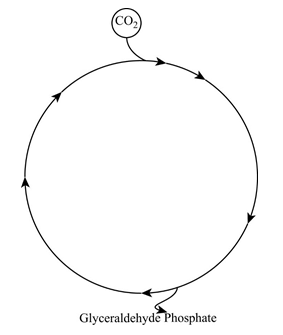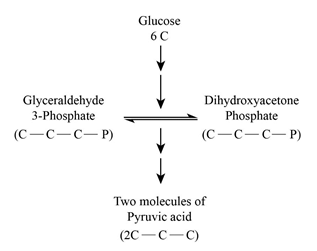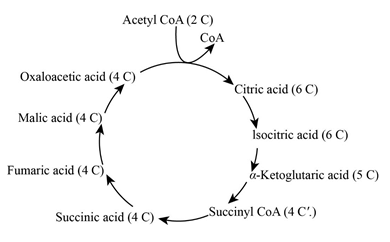
Concept explainers
To name:
The pathways diagrammed in parts (a), (b), and (c) of the given figure.
Introduction:
Cellular mechanisms involved in many reactions in which the transfer of electrons from one molecule to another take place by means of
Explanation of Solution
- The given diagram is the Calvin-Benson cycle. In this cycle, three molecules of carbon dioxide are fixed and one molecule of glyceraldehyde 3-phosphate is produced. After that, it leaves the cycle is shown in the below diagram.
- The given b diagram resembles the Glycolysis pathway. In this pathway, the oxidation of glucose yields two molecules of pyruvic acid as its end product.
- The below-given diagram is the Kreb’s cycle. Here, the decarboxylation of pyruvic acid produces one carbon dioxide molecule and one acetyl group.



To review:
The anabolic and catabolic mechanisms in the given pathways.
Introduction:
The cellular mechanism of all living organisms requires the energy for its
Explanation of Solution
Glycolysis and the Citric acid cycle are the major pathways for anabolic and catabolic mechanisms of all organic molecules, such as carbohydrates, lipids, and proteins. Glycerol is catabolized as Dihydroxyacetone phosphate in the Glycolysis pathway (a) and fatty acids are catabolized as acetyl CoA int he TCA cycle (b).
Glutamic acid is catabolized in the Krebs cycle (c). Glutamic acid is an amino acid which is catabolized by Kreb’s cycle at α-ketoglutaric acid which is formed from isocitric acid.
In the Calvin-Benson cycle, Glyceraldehyde 3-phosphate is the end product, which enters into glycolysis. In glycolysis, the glucose is oxidized into pyruvate which is decarboxylated to acetyl group and entered into the Kreb’s cycle.
The Calvin cycle requires 18 molecules of ATP between glucose and glyceraldehyde 3- phosphate.
Three molecules of carbon dioxide (CO2) is released in the Kreb’s cycle,
- Between pyruvate to acetyl CoA.
- Between isocitric acid to α-ketoglutarate (TCA cycle).
- Between α-ketoglutarate to succinyl CoA.
The long chain hydrocarbon like such as acetyl group is catabolized in the TCA cycle at acetyl CoA. This acetyl group like hydrocarbons are catabolized by beta-oxidation which enters into the Kreb’s cycle.
The production of NADH, FADH2 or NADH in glycolysis, Calvin-Benson and TCA cycles are,
The anabolic and catabolic pathways are integrated between,
- In glycolysis, the anabolic and catabolic pathways integrated into dihydroxyacetone phosphate.
- In the TCA cycle, the anabolic and catabolic pathways integrated into acetyl, oxaloacetic acid and ketoglutaric acid.
| Utilizes | Produces | |
| Glycolysis | 2 NADH | |
| Calvin-Benson cycle | 6 NADPH | |
| Pyruvate to acetyl CoA | 1 NADH | |
| Isocitrate to α-ketoglutaric acid | 1 NADH | |
| α-keto-glutaric to succinyl CoA | 1 NADH | |
| Succinate to fumarate | 1 FADH2 | |
| Malate to oxalate | 1 NADH |
Want to see more full solutions like this?
Chapter 5 Solutions
Microbiology: An Introduction
- A patient complains of painful muscle cramps when performing strenuous physical exercise. A muscle biopsy indicates a higher than normal concentration of muscle glycogen. a. Which enzyme of glycogen metabolism is affected? b. Discuss how the defect of this enzyme affects glycogen metabolism.arrow_forwardThe following are the negative regulators of phosphofructokinase except Select one: a. AMP +b. H c. Citrate d. ATParrow_forwardThe reaction catalyzed by glyceraldehyde 3-phosphate dehydrogenase involves two "sub-reactions", one of which is unfavourable. How is the energy barrier of this unfavourable sub reaction overcome? A. through the formation and hydrolysis of a thioester bond using a cysteine molecule in the enzyme B. through the hydrolysis of an ATP molecule C. through the hydrolysis of a thioester bond in the substrate molecule D. the enzyme catalyzes the formation of a thioester bond E. none of these explanations describe how the energy barrier is overcome Please answer asaparrow_forward
- Five coenzymes are required by a-ketoglutarate dehydrogenase, the enzyme in the citric acid cycle that converts a-ketoglutarate to succinyl-CoA.a. Identify the coenzymes.b. Propose a mechanism for the reaction.arrow_forwardWhat are the correct names of the items, I, II and III in the reaction given below? a. Fructose-6P / Phosphofructokinase / Ribose-1,6P b. Glucose-6P / Hexokinase / Glucose-1,6 P c. Fructose-6P / Glucokinase / Glucose-1,6 P d. Fructose-6P/ Phosphofructokinase / Fructose-1,6 P e. Fructose-6P / Phosphoglucose isomerase / Fructose-1,6 Parrow_forwardWhen transaminated, the three branched-chain amino acids (valine, leucine, and isoleucine) form compounds that have the characteristic odor of maple syrup. An enzyme known as branched-chain a-keto acid dehydrogenase converts these compounds into CoA esters. People who do not have this enzyme have the genetic disease known as maple syrup urine disease, so called because their urine smells like maple syrup. a. Draw the compounds that smell like maple syrup.b. Draw the CoA esters.c. Branched-chain a-keto acid dehydrogenase has five coenzymes. Identify them.d. Suggest a way to treat maple syrup urine disease.arrow_forward
- Order the steps that results in a triacylglycerol containing two palmitic acids and one stearic acid. a. Diacylglycerol reacts with an fatty-acyl-CoA b. Phosphate is remove from phosphatidic acid to form diacylglycerol c. Two of the fatty acyl-CoAs react with glycerol-3-phosphate d. An elongase produce stearic acid e. Stearoyl-CoA is synthesized…arrow_forwardThe molecule shown below is an important compound involved in glucose metabolism. CH2 OH CH,OH но a. What is the name of this compound? b. Draw the structure of the precursor of this molecule. What is the name of the enzyme that catalyzes the formation of the product? c. Discuss how the hormone glucagon affects the concentration of this molecule. Include in your discussion the role this molecule has in glucose metabolism and its regulation.arrow_forwardFor each of the following conditions, state whether this condition would be occurring during gluconeogenesis, glycolysis, or both in liver cells. a. Transporting malate from the cytosol into the mitochondria. _____________ b. Transporting pyruvate from the cytosol into the mitochondria. _____________ c. We would have an increased (or increasing) concentration of F26BP. __________ d. Increased concentration of F6P.__________ e. Hexokinase IV (or glucokinase) is found in the nucleus of the cell. __________ f. The enzyme that synthesizes/breaks down F26BP is phosphorylated. __________ g. Elevated levels of glucagon in the blood. ____________arrow_forward
- Define the following terms: a. respiratory control b. glycerol-3-phosphate shuttle c. uncoupling protein d. oligomycin e. malate–aspartatearrow_forwardOne effect of chronic alcohol abuse is thiamine deficiency, caused by impaired absorption of the vitamin through the intestinal wall and diminished storage in a damaged liver. When thiamine levels are inadequate, cellular energy generation is diminished. List three enzymes involved in cellular metabolism that require thiamine. Describe the possible metabolic consequences of inadequate thiamine levels.arrow_forwardA. Energy is released in the process of lipid degradation. (i) Into which form is the fatty acid converted when it is transported across the inner membrane of mitochondria? (ii) Write an overall reaction for B-oxidation of a 22:0 fatty acid. (iii) Calculate the NET amount of ATP produced in (ii). Show your steps of calculation. B. Compare the mode transport of amino acids and fatty acids from the lumen of small intestine into the epithelial cells of villi. C. Briefly discuss why part of urea cycle takes place in mitochondria.arrow_forward
 Human Anatomy & Physiology (11th Edition)BiologyISBN:9780134580999Author:Elaine N. Marieb, Katja N. HoehnPublisher:PEARSON
Human Anatomy & Physiology (11th Edition)BiologyISBN:9780134580999Author:Elaine N. Marieb, Katja N. HoehnPublisher:PEARSON Biology 2eBiologyISBN:9781947172517Author:Matthew Douglas, Jung Choi, Mary Ann ClarkPublisher:OpenStax
Biology 2eBiologyISBN:9781947172517Author:Matthew Douglas, Jung Choi, Mary Ann ClarkPublisher:OpenStax Anatomy & PhysiologyBiologyISBN:9781259398629Author:McKinley, Michael P., O'loughlin, Valerie Dean, Bidle, Theresa StouterPublisher:Mcgraw Hill Education,
Anatomy & PhysiologyBiologyISBN:9781259398629Author:McKinley, Michael P., O'loughlin, Valerie Dean, Bidle, Theresa StouterPublisher:Mcgraw Hill Education, Molecular Biology of the Cell (Sixth Edition)BiologyISBN:9780815344322Author:Bruce Alberts, Alexander D. Johnson, Julian Lewis, David Morgan, Martin Raff, Keith Roberts, Peter WalterPublisher:W. W. Norton & Company
Molecular Biology of the Cell (Sixth Edition)BiologyISBN:9780815344322Author:Bruce Alberts, Alexander D. Johnson, Julian Lewis, David Morgan, Martin Raff, Keith Roberts, Peter WalterPublisher:W. W. Norton & Company Laboratory Manual For Human Anatomy & PhysiologyBiologyISBN:9781260159363Author:Martin, Terry R., Prentice-craver, CynthiaPublisher:McGraw-Hill Publishing Co.
Laboratory Manual For Human Anatomy & PhysiologyBiologyISBN:9781260159363Author:Martin, Terry R., Prentice-craver, CynthiaPublisher:McGraw-Hill Publishing Co. Inquiry Into Life (16th Edition)BiologyISBN:9781260231700Author:Sylvia S. Mader, Michael WindelspechtPublisher:McGraw Hill Education
Inquiry Into Life (16th Edition)BiologyISBN:9781260231700Author:Sylvia S. Mader, Michael WindelspechtPublisher:McGraw Hill Education





